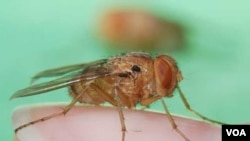Ormia ochracea, a tiny yellow parasitic fly native to Central America and the southern United States, has an unusual habit.
It deposits larvae onto the backs of crickets, which burrow into the insects and consume them from the inside out.
The fly locates its host by listening for the cricket's high-pitched chirp, which it can hear from as far away as the length of a football field, and pinpoint its location.
It's something no other insect can do. In fact, O. ochracea's ear structure is so unique that it's now the model for what may be a new generation of hypersensitive hearing- and sonic-aid devices.
“The fly has a clever mechanism that instead of using two independent ears, like a human would, the fly’s ears are actually coupled,” says Professor Neal Hall, an acoustic engineer at the University of Texas, Austin.
With ears set two millimeters apart — a separation so slight that sound reaches one ear just four millionths of a second before arriving at the other — O. ochracea also an internal feature that resembles a tiny see-saw. At only 1.5 millimeters long, this latter feature is forced into motion by the pressure of soundwaves, which increase the sound delay and allow the fly to zero in on its prey.
In the journal Applied Physics Letters, Hall and colleagues at the University of Texas report on a prototype of the fly’s hearing structure they built, based on previous studies.
They copied the see-saw mechanism in silicon and used special electric materials to measure its flex and rotation.
The prototype, they found, localizes audible sound just like the fly.
After discerning the motion of the structure, the researchers then computed the direction of the sound source.
Hall sees applications of the work moving in two directions: on the battlefront, where sensors would be critical to localize where shots are originating, and in health care to supply hearing devices that could filter out distracting background sound.
“One thing the fly teaches us how to do is to hear in a certain direction, while rejecting sound coming from other directions," he said. "That is a feature that is incredibly useful for hearing aids, for example, where right now, if you turn up the gain of a hearing aid or turn up the volume to hear someone across from you, it also amplifies everything else in the room."
Hall says the remaining challenge in bringing such products to market is making them practical to handle.
"Because the device is so small, it is delicate," a concern the fly does not have to worry about, he says.










